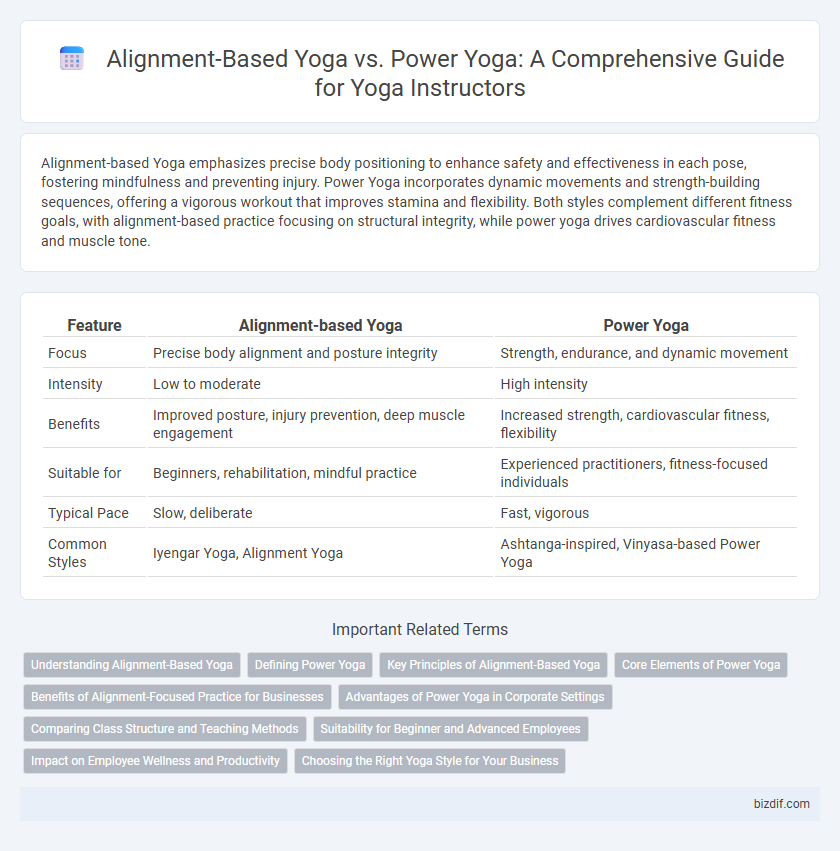Alignment-based Yoga emphasizes precise body positioning to enhance safety and effectiveness in each pose, fostering mindfulness and preventing injury. Power Yoga incorporates dynamic movements and strength-building sequences, offering a vigorous workout that improves stamina and flexibility. Both styles complement different fitness goals, with alignment-based practice focusing on structural integrity, while power yoga drives cardiovascular fitness and muscle tone.
Table of Comparison
| Feature | Alignment-based Yoga | Power Yoga |
|---|---|---|
| Focus | Precise body alignment and posture integrity | Strength, endurance, and dynamic movement |
| Intensity | Low to moderate | High intensity |
| Benefits | Improved posture, injury prevention, deep muscle engagement | Increased strength, cardiovascular fitness, flexibility |
| Suitable for | Beginners, rehabilitation, mindful practice | Experienced practitioners, fitness-focused individuals |
| Typical Pace | Slow, deliberate | Fast, vigorous |
| Common Styles | Iyengar Yoga, Alignment Yoga | Ashtanga-inspired, Vinyasa-based Power Yoga |
Understanding Alignment-Based Yoga
Alignment-Based Yoga emphasizes precise body positioning to enhance physical balance, prevent injury, and deepen awareness of muscle engagement. It focuses on intentional movement and breath coordination, promoting mindfulness throughout each pose. This method contrasts with Power Yoga's faster pace and strength-driven sequences, offering a foundational approach ideal for developing safe practice habits and body intelligence.
Defining Power Yoga
Power Yoga emphasizes dynamic sequences and strength-building postures derived from Ashtanga yoga to increase stamina and muscle tone. Unlike Alignment-based Yoga, which prioritizes precise body positioning to prevent injury and promote mindfulness, Power Yoga focuses on continuous movement and cardiovascular fitness. This style caters to practitioners seeking a vigorous workout that enhances flexibility and overall physical endurance.
Key Principles of Alignment-Based Yoga
Alignment-based Yoga emphasizes precise body positioning to enhance joint safety, muscle engagement, and overall balance during practice. Key principles include mindful awareness of anatomical cues, controlled movement transitions, and maintaining structural integrity to prevent injury and promote optimal energy flow. This approach contrasts with Power Yoga's dynamic, fitness-oriented sequences by prioritizing conscious alignment and sustainable body mechanics.
Core Elements of Power Yoga
Power Yoga emphasizes dynamic movements and strength-building postures that target the core, enhancing stability and endurance. Its core elements include fluid sequences, intense breathing techniques, and isometric holds designed to activate deep abdominal muscles and improve overall body control. Unlike alignment-based yoga, Power Yoga prioritizes cardiovascular intensity and muscular engagement for a more vigorous practice.
Benefits of Alignment-Focused Practice for Businesses
Alignment-based yoga enhances employee well-being by promoting posture correction, reducing injury risk, and improving mental clarity, which leads to increased productivity. This practice fosters a mindful work environment, encouraging sustained focus and stress management. Businesses experience lower healthcare costs and higher employee satisfaction through the integration of alignment-focused yoga programs.
Advantages of Power Yoga in Corporate Settings
Power Yoga enhances cardiovascular health and builds muscular strength, making it ideal for busy professionals seeking efficient workouts during limited breaks. Its dynamic sequences improve focus, energy levels, and stress resilience, which boosts productivity and mental clarity in high-pressure corporate environments. Unlike alignment-based yoga, Power Yoga's fast pace fosters endurance and agility, supporting sustained performance throughout demanding workdays.
Comparing Class Structure and Teaching Methods
Alignment-based Yoga classes emphasize precise posture adjustments and slow, mindful movements guided by detailed verbal cues to ensure anatomical correctness and injury prevention. Power Yoga classes focus on dynamic, high-intensity sequences designed to build strength and endurance, often incorporating fast transitions and fewer alignment corrections. Teachers in alignment-based classes prioritize individualized feedback, while Power Yoga instructors encourage flow and cardiovascular engagement with less emphasis on strict form.
Suitability for Beginner and Advanced Employees
Alignment-based Yoga emphasizes precise body positioning and is ideal for beginners seeking foundational stability and injury prevention, while advanced practitioners benefit from its focus on mindful movement. Power Yoga offers a dynamic, strength-building experience suited to advanced employees aiming for increased endurance and flexibility, though it may challenge beginners due to its intensity. Selecting between Alignment-based and Power Yoga depends on individual fitness levels and goals within workplace wellness programs.
Impact on Employee Wellness and Productivity
Alignment-based yoga emphasizes precise body positioning and mindful movement, reducing workplace injuries and enhancing mental clarity, which boosts employee wellness and sustained productivity. Power Yoga incorporates dynamic postures and strength-building sequences, increasing cardiovascular fitness and energy levels, leading to improved focus and stamina during work hours. Both styles contribute uniquely by fostering physical health and stress reduction, essential for maintaining high performance in demanding professional environments.
Choosing the Right Yoga Style for Your Business
Alignment-based Yoga emphasizes precise postures and body mechanics, promoting injury prevention and therapeutic benefits ideal for clients seeking mindful practice. Power Yoga offers dynamic, strength-building sequences that attract fitness-focused individuals aiming to increase endurance and flexibility. Selecting the right yoga style for your business depends on your target audience's goals, whether prioritizing holistic wellness through alignment or high-energy workouts via Power Yoga.
Alignment-based Yoga vs Power Yoga Infographic

 bizdif.com
bizdif.com